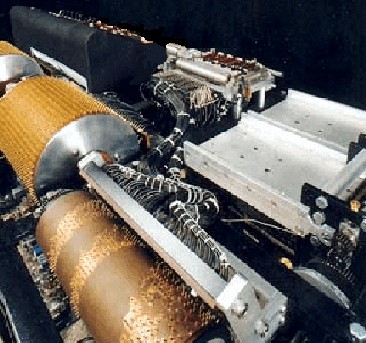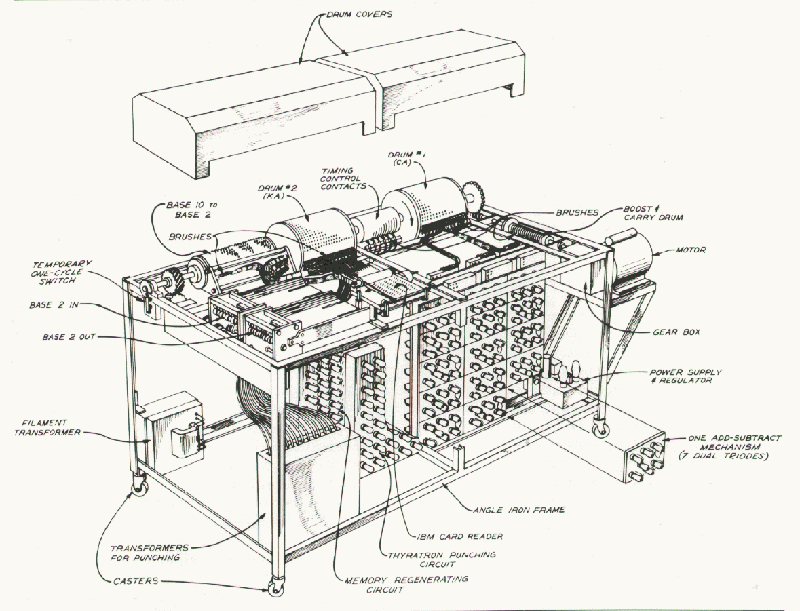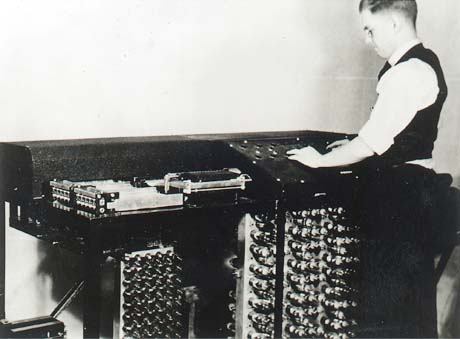



John Vincent Atanasoff
1903-1995
The Atanasoff family itself had an unusual history. Ellis
island officials had changed their Bulgarian name of Atanasov into Atanasoff
when the thirteen year old Ivan (John Vincent's grandfather) had arrived in the
United States in 1889. Ivan had never know his father who had been shot by soldiers of the Ottoman Empire during the April Uprising
of 1876.
John Vincent Atanasoff was born near Hamilton, New York on October the 4th 1903.
1903 also marked the family's move to Florida. John Vincent was the first
child John Atanasoff, an electrical engineer, and a mathematic teacher Iva Lucena Purdy.
John Vincent took an early interest in mathematics while attending grade school
in Brewster, FL. His father taught him the basics of electricity.
when John was about ten his father brought home a slide rule, which fascinated
the young Atanasoff, who learned the mathematics and history behind the device
as well as it operation. His mother worked with him to master J.M.Taylor's
College Algebra, which first exposed him to base two numbers.
John graduated high school in two years with perfect A grades in science and mathematics.
1921 marked John's entrance into University of Florida, Gainesville after some
time working to raise money. In 1925 Atanasoff received his B.S. in
electerical engineering. He accepted his first offer of teaching fellowship
and went to Iowa State College in Ames, Iowa in 1925. His
choose Iowa over numerous offers, including one from
Harvard. A year later, 1926, Iowa State granted Atanosoff his M.A.
in mathematics. He married his wife Lura Meeks and moved to Madison to
pursue his Ph.D. at the University of Wisconsin. Atanasoff's doctoral
thesis: The Dielectric Constant of Helium required the same sort of
laborious calculations as those that would motivate Konrad Zuse.
Like Zuse , Atanasoff was inspired to find a better way.
In 1930, with his Physics Ph.D. in hand, Atanasoff returned to Iowa State
College with his research goal of building faster and better computing
machines. Though promoted to assistant professor in mathematics and
physics, Atanasoff's dream of a computing machine was no further along. A
frustrated Atanasoff set off on an impromptu road trip. Stopping at a bar
in Illinois
some 200 miles later, Atanasoff had an epiphany. Back in Iowa, he
constructed a working prototype with a young and equally brilliant graduate
student Clifford Berry, which won them a
$850 grant from The Iowa State College Research Council to build a fully
operational version with the capacity to solve systems of equations. Issues
about patents and an need for more funding lead the two to write Computing Machines for the Solution of Large Systems of Linear Algebraic
Equations which outlined their work. World War II halted the project,
and Atanasoff left Ames to join in the war effort.
In 1939 Atanasoff was working at the Naval Ordnance Laboratory in Washington, D.C.. He soon became Chief of the Acoustics Division, during which time he developed a computer for the United States Navy, worked on mines and mine counter measures, and was involved in the first atomic test in the Pacific on Bikini Atoll.
In 1940 Atanasoff met John Mauchly at the latter's lecture at Ursinus College. Mauchly spent several days at the Atanasoff home, where he was briefed extensively on the ABC and saw it demonstrated. Mauchly left the Atanasoff home with papers describing the principles and design of the ABC. Mauchly together with J. Presper Eckert would later design and construct ENIAC (Electronic Numerical Integrator And Computer) which was hailed as world's first electronic digital computer. Mauchly and Eckert were likewise treated as the father's of modern computers. In 1972 U.S. District Judge Earl Larson ruled that the ENIAC was "derived" from the work of Atanasoff.
By 1949 Atanasoff was a chief scientist for the Army Field Forces in Fort Monroe,
VA. In 1950 he accepted the post of Director of the Naval Fuse Program at the Naval Ordnance Laboratory in Washington D.C..
In 1952 he created a private firm, The Ordnance Engineering Corporation.
He sold OEC to Aerojet General Corporation in 1957, becoming their Atlantic
Division Manager, and later their Vice-President. He retired in 1961, and
devoted his life to computer education for children. John Vincent Atanasoff died of a stroke on June the 15th 1995.
Honors
US Navy Distinguished Service Award (1945).
Citation, Seismological Society of America (1947).
Citation, Admiral, Bureau of Ordnance (1947).
Cosmos Club Membership (1957).
Order of Cyrille and Methodius, First Class, Bulgarian Academy of Science.
Iowa Inventors Hall of Fame.
Plaque, Iowa Stat University, Physics Building (1974).
Doctor of Science University of Florida (1974).
Doctor of Science Moravian College (1981).
Distinguished Achievement Citation, Iowa State University Alumni Association (1983).
Doctor of Science Western Mayland College
Peoples Republik of Bulgaria Medal, First Class.
Holly Medal, US Society of Engineers, given by vice president George Bush (1985).
Coors American Ingenuity Award (1986)
Atanasoff scholarship, founded by Adolph Coors Company (1986).
Doctor of Science State University of Wisconsin (1987)
The Bulgarian National Astronomic Observatory at Rozhen discovers an astero´d near Mars and names it the Atanasoff.
Information Resource Management Hall of Fame, Washington DC (1989).
National Medal of Science and Technology for 1990. This medal was presented by President George Bush in the White House (1990).
President George Bush presents the National Medal of Science and Technology for 1990 to John Vincent Atanasoff.
 |
 |
 |
 |
Links
| Digidome Biography | Virginia Tech's Biography | CSIS Slide Show on Atanasoff |
| Behoop Bytes Biography of Aiken | Harvard Gazette Aiken Article | Kilen Mathews Biography |